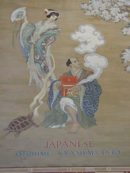I have been working on a translation here at the public library in Birmingham, Alabama. There are large murals painted on the interior walls of the research library where I am sitting as I write this and it struck me that I couldn’t figure out what concept united all the murals.
They were painted by Ezra Winter back in the 1920s. Each mural appears to be representing a nation or culture, but I was puzzled by the choices made.
To represent the English we had Lancelot, a fictitious legendary figure. The Russians got Igor, the Spanish got Don Quixote, the Germans got Faust and Margaret. I thought the theme was fictional characters from literary works, but there were real historical figures as well: John Smith and Pocahontas for Americans, Dante and Virgil for Italians (though I realize they are probably taken from within the Divine Comedy), and Confucius for the Chinese. See the full list here.
I concluded that they were all chosen as figures which might reasonably pop up, fictional or otherwise in a classical education. However, I still found the choices somewhat bizarre when juxtaposed with the nation or culture they are supposed to represent.
I confess I didn’t recognize the characters for Japan: Otohime and Urashima Tarô, until I looked up the familiar story (J) online. The two are apparently now available in Hello Kitty versions.
The only Otohime I remember coming across in Japan was the device occasionally found in bathrooms to conceal the noise of one’s bowel movements. Only now do I realize that the name was not just a “Sound Princess” (音姫) but was at least potentially an additional play on the pronunciation of a version of the name of the mythical characther (乙姫).







